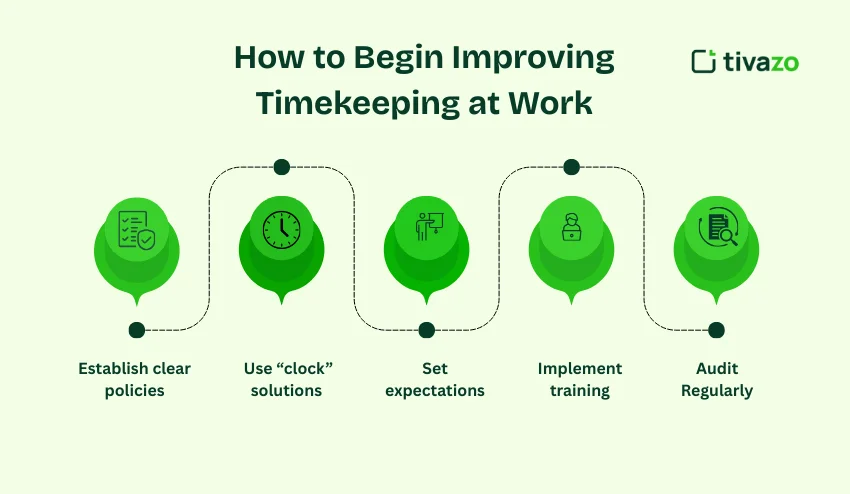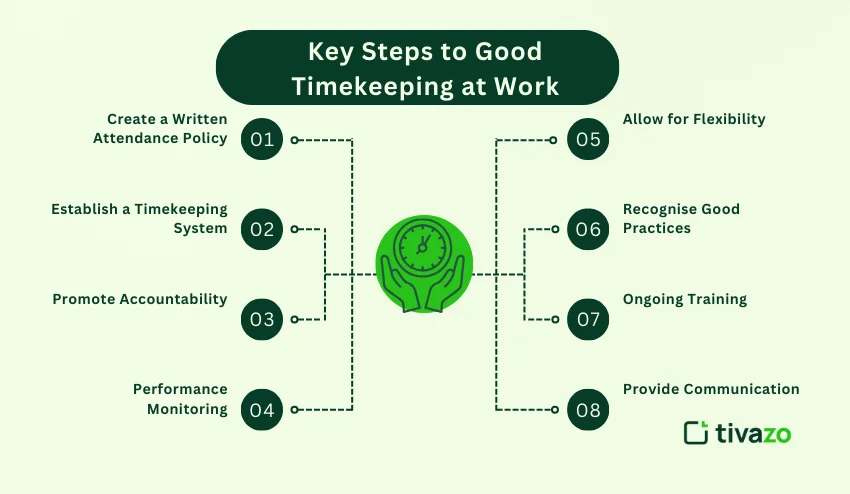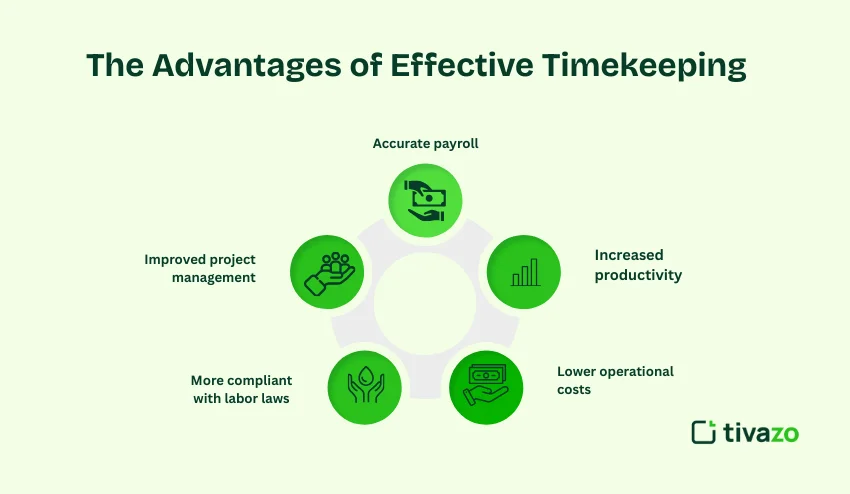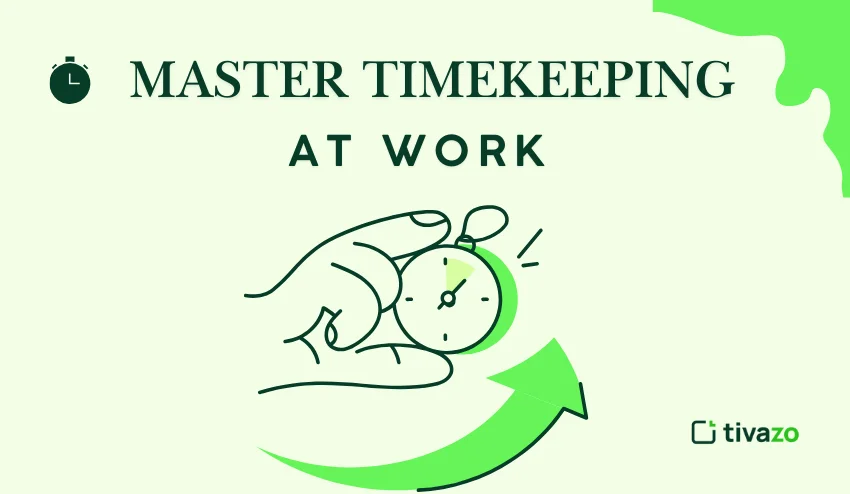Tracking time at work is the foundation of productivity, accountability, and even business success in total. When timekeeping at work is done correctly and efficiently, assignments are completed on time, payroll is processed promptly, and a strong level of performance is established. Efficient timekeeping at work also allows a manager to accurately keep track of the completion and security of the project, measure performance, and assess compliance with labor standards.
Good timekeeping at work not only makes workers feel accountable and responsible, but it also firmly establishes a company-wide understanding of punctuality and consistent performance. Even with these advantages, many organizations face similar problems of lost time through inadequate timekeeping and lack of employee accountability, which leads to missed deadlines and ultimately, decreased performance overall.
In the body of this blog, we will cover what timekeeping at work means, common problems associated with timekeeping at work, and 10 proven techniques to help you improve timekeeping at work for ongoing success. By identifying the importance of solid timekeeping practices at work organizations can create simple and meaningful initiatives to improve accountability and productivity for employees, timeliness across operations, and efficiencies throughout the whole organization. Good timekeeping at work is not just about tracking ‘hours worked‘, it is about creating an effective, efficient, accountable, and high-performing workforce.
What is Timekeeping in the Workplace?
Timekeeping is the tracking, recording, and administration of the hours employees spend on work-related activities; in essence, it maintains accuracy in work schedules, payroll, and productivity metrics.
Timekeeping at work can either be manual systems like punch cards or automated ones using online time-tracking software, but either way, it is simple to reduce frosty costs, sustain compliance, and develop employee accountability.
What you need to know about timekeeping at work:
- Accurate recording of hours worked and overtime
- Accurate working hours are used to determine payroll; otherwise, payroll is simply a guess.
- Detailed tracking gives you the data to see trends in employee productivity
- Serves as proof of compliance with labor laws and company policy limitations
- Keeps time theft and buddy punching to a minimum
- Gives management the information necessary to manage resources better
- Accountability and discipline are encouraged
- Better scheduling and project planning can be realized by your teams
Timely productivity, the tracking of working hours, and reducing wasted costs are possible for organizations that learn how to manage timekeeping at work and develop a policy of accountability and transparency.
What Does Timekeeping at Work Mean?
At work, timekeeping at work means a lot more than simply putting on and taking off a time clock. It denotes discipline, responsibility, and respect for organizational goals. Good timekeeping at work ensures:
- Employees arrive and leave on time.
- Overtime and breaks are entered accurately.
- Work time is aligned with company policy.
- Productivity is measured.

Beyond these essential functions, timekeeping at work is also a key part of improving your overall workflow and facilitating team coordination. Good timekeeping at work also means that managers can identify bottlenecks, get a sense of project timelines, and ensure resources are appropriately allocated. Good timekeeping at work instills accountability in employees, minimizes conflicts in working order, supports performance evaluation, provides transparency for the employee and supervisor, builds trust, and creates a culture of accountability.
In today’s highly competitive workspace, there are many reasons to encourage good timekeeping at work. Ultimately, performing good timekeeping can increase productivity, lower costs, and set the company up for long-term success.
Issues with Employee Timekeeping
Regardless of the importance of timekeeping at work, many organizations struggle with inaccurate timekeeping practices. Below are some challenges:
| Problem | Business Impact | Example |
| Late Employees | Delayed operations | Employees regularly show up 15 minutes late |
| Early Employees | Lost work time | Employees leaving before their shift ends |
| Buddy Punching | Payroll fraud | Colleagues clocking in for employees who do not show up for work |
| Missed Meal Breaks | Legal or compliance issues | Employees skipping lunch breaks and not logging the time |
| Errors in Timekeeping | Inaccurate reporting of hours | Employees misreporting hours on timesheets |
Poor timekeeping at work impacts not only daily operations but can also have repercussions on project timelines at work and team dynamics. There can also be discrepancies in payroll as a result of poor timekeeping practices, which can make for unhappy employees. Over time, poor timekeeping practices can bring about a decline in productivity, poor morale, and even subsequently higher turnover rates.
Organizations that do not combat poor timekeeping will see a decline in bottom-line profits and deteriorating organizational culture. Using the right policy and a time-tracking system, combined with regular monitoring, organizations will be able to mitigate cases of poor timekeeping and foster a more accountable workforce.
Examples of poor timekeeping at work
- Examples of poor timekeeping at work include:
- Frequently arriving late or leaving early.
- Taking extended breaks when not entitled to them.
- Forgetting to clock in or clock out.
- Recording hours not worked.
- Missing deadlines because of poor scheduling.
The impacts of each of these examples of poor timekeeping at work are not only lost hours. These behaviors can have more significant impacts that can affect teams, work collaboration, project completion, etc. Frequently arriving late or leaving early puts another barrier to collaborating with coworkers or completing team projects. Taking a long authorized break or an extended break that is not approved decreases available time to work and impacts the productivity of the team, even if the person taking the longer break is not affecting their other colleagues, as evidenced in productivity measures.
Forgetting to clock in or clock out leads to inaccuracies in payroll, which can lead to disputes over payment and further erode trust with a company when employees do not receive payment for hours worked. Logging inaccurate work hours can also lead to misunderstandings of employee performance. Poor scheduling can lead to missed deadlines, overworked employees, and unhappy clients if missed project deadlines are part of the issue. Ultimately, poor timekeeping at work causes a lack of trust, inefficiency, and may negatively influence a company’s reputation and bottom line.
How to Begin Improving Timekeeping at Work
Improving timekeeping in the workplace doesn’t need to be complicated. Here are the first actions you can take:
- Establish clear policies – Establish rules as they relate to things like attendance, breaks, and overtime.
- Use “clock” solutions – Put in expensive time-tracking systems, as they will cut down on errors.
- Set expectations – Explain the importance of timekeeping to your employees, for both the business and the employee.
- Implement training – Train employees on how to record their hours worked and general procedures.
- Audit regularly – Regular audits of time records can surface irregularities.

It is also beneficial to get employees on board by sharing ways in which accurate timekeeping helps them as a group and individually. Managers can provide feedback on their employees ‘ timekeeping, share favourable instances, and address them immediately, while also encouraging accountability. If you can foster a culture of importance for punctuality and proper logging, or at least some element of it, you will eventually see long-term improvements.
If you can break down what can be done into small steps, like reminders and monitoring who clocks in and out with a plan of weekly meetings to review logs, you can have a positive impact on minimizing errors and improving overall workforce good practice. By using this plan it will also help ensure that timekeeping practices become regular and automatic.
Key Steps to Good Timekeeping at Work
Organisations should follow the following key steps for continued success:
1. Create a Written Attendance Policy
A written policy provides employees with guidelines to understand what timekeeping at work looks like and creates expectations regarding punctuality, breaks, and overtime.
2. Establish a Timekeeping System
Digital time keeping provides usable time keeping tools, like biometric time clocks or apps, that allow employers to remove errors and eliminate buddy punching while providing easier and accurate logged hours.
3. Promote Accountability
Managers need to promote a culture of accountability where employees take personal responsibility for reporting their time worked and punctuality.
4. Performance Monitoring
Reporting can help to identify frequent late arrivals, continual time abuse, and patterns of absenteeism. This will enable supervision by identifying and addressing issues before they become problems.
5. Allow for Flexibility
Allowing for flexible hours can also make employees feel motivated and reduce issues with timekeeping at work, while also allowing them to balance their professional and personal responsibilities.
6. Recognise Good Practices
Finding ways to reward employees who display good practices regarding timekeeping at work will reinforce its importance. Recognition can take many forms – it could be a monetary incentive or incentive, praise, or public praise.
7. Ongoing Training
Bring employees together for workshops, or ongoing refresher courses on timekeeping at work policies, and/or tools, will ensure employees are always informed and in compliance.
8. Provide Communication
Being transparent and communicating regularly about what management expects for attendance, any policy changes, and performance. This will be advantageous in showing employees what management expectations are to reinforce or change employees’ misconceptions regarding timekeeping at work.

The Advantages of Effective Timekeeping
What are the advantages of effective timekeeping practices at work? Implementing effective timekeeping practices in the workplace provides the following advantages:
- Accurate payroll – It helps ensure workers are being paid accurately for their hours worked (reducing disputes and mistakes).
- Increased productivity – When carried out correctly, timekeeping can reinforce punctuality and the proper utilization of work hours, which likely improves productivity.
- Lower operational costs – Reduces wasting time, overtime, and time mismanagement.
- More compliant with labor laws – Assists the organization in maintaining correct working hours, break policies, and overtime laws, thus reducing the risk of litigation.
- Improved project management – Better facilitates established timelines, resource allocation, etc.

Effective timekeeping approaches continue to cultivate a climate of accountability and professionalism. Employees are more mindful of their obligations, which will contribute to increased morale and greater employee engagement overall. Effective timekeeping practices can also be a useful tool when considering performance reviews, promotion timelines, and workforce planning on a departmental or organizational level.
Conclusion
Timekeeping at work is important for accountability, productivity, and efficiency. Timekeeping means the process of tracking and managing employee hours to ensure accurate payroll, compliance, and consistent business processes. Poor timekeeping at work can lead to late arrivals, missed deadlines, payroll mismanagement, and ultimately less morale from workers. Organizations can improve timekeeping by developing policies that promote attendance, utilizing technology to track time, providing employee training on acceptable practices, and monitoring progress.
In addition, promoting accountability, providing some flexibility, and promoting good practice is a great way to enforce workplace discipline. Good timekeeping at work contributes to productivity, reducing labour costs and providing better management of projects, which in turn can create motivated, efficient, and high-performing employees.



